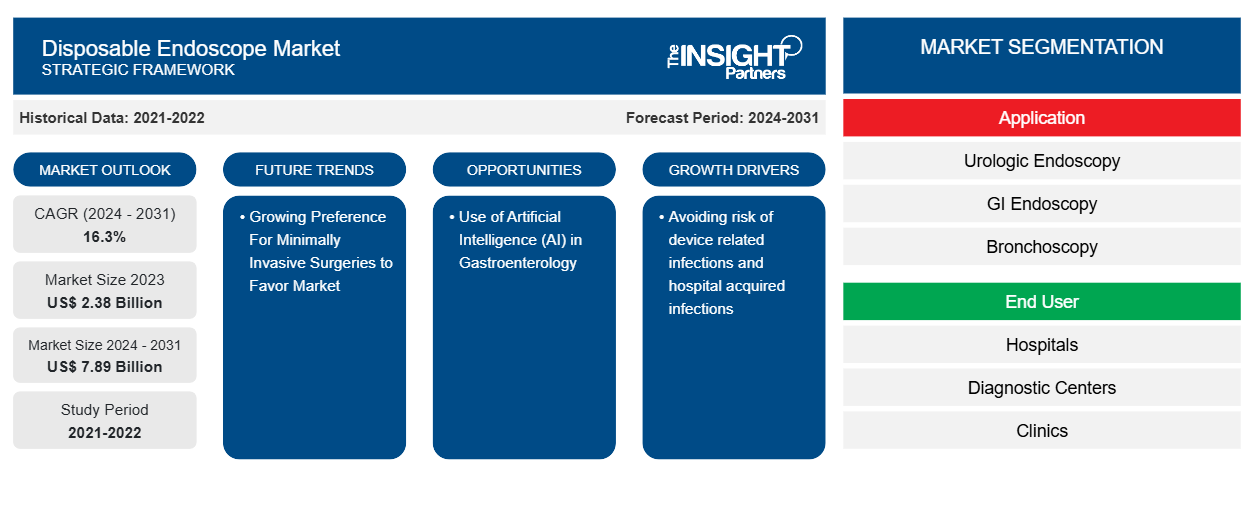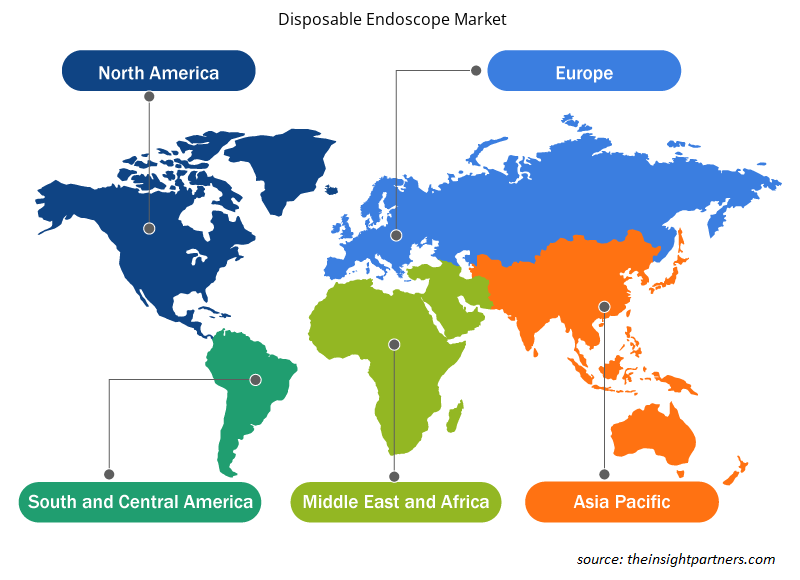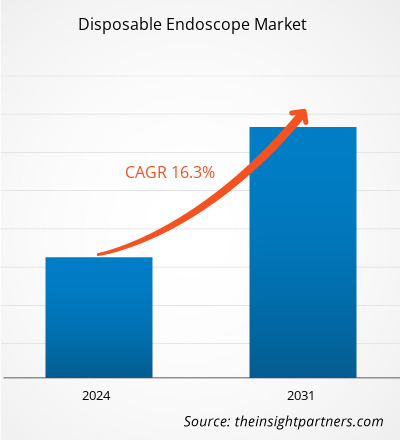The disposable endoscope market size is projected to reach US$ 7.89 billion by 2031 from US$ 2.38 billion in 2023. The market is expected to register a CAGR of 16.3% during 2024–2031. Avoiding risk of device related infections and hospital acquired infections coupled with favourable government scenario are likely to remain key trends in the market.
Disposable Endoscope Market Analysis
According to a report by the World Health Organization (WHO) on the burden of hospital acquired infections (HAIs) around the world, the rate of HAIs ranges from 3.6 to 12% in high-income countries and from 5.4 to 19.1% in low- and middle-income countries, as of 2022. This led to the use of single- use endospcopic devices in the recent past and is expected to continue a similar trend during the forecast period. Increasing funds and investments by government and other companies is expected to propel the growth of overall disposable endoscope market.
Disposable Endoscope Market Overview
Growing risk of infection transmission with reusable endoscopes has led the growth of disposable endoscope market. According to HHS.gov, as of 2021, about 1 in 31 inpatients have an infection related to hospital care. These infections lead to tens of thousands of deaths and cost the U.S. health care system increased exponentially each year. 6% of hospitalized patients in the 2021 survey had one or more HAI. There were an estimated 887,000 HAIs in U.S. acute care hospitals in 2021. About 90,000 hospital patients with HAIs died during their hospitalizations. Such a factor has resulted in the growth of disposable endoscope market.
Customize This Report To Suit Your Requirement
You will get customization on any report - free of charge - including parts of this report, or country-level analysis, Excel Data pack, as well as avail great offers and discounts for start-ups & universities
Disposable Endoscope Market: Strategic Insights

- Get Top Key Market Trends of this report.This FREE sample will include data analysis, ranging from market trends to estimates and forecasts.
You will get customization on any report - free of charge - including parts of this report, or country-level analysis, Excel Data pack, as well as avail great offers and discounts for start-ups & universities
Disposable Endoscope Market: Strategic Insights

- Get Top Key Market Trends of this report.This FREE sample will include data analysis, ranging from market trends to estimates and forecasts.
Disposable Endoscope Market Drivers and Opportunities
Growing Preference For Minimally Invasive Surgeries to Favor Market
Minimally Invasive Surgeries (MIS) cause less post-operative pain, so patients receive less painkillers. As minimal cuts or stitches are involved, hospitalization is relatively shorter, and patients need not visit the hospital frequently. People prefer minimally invasive proceduresv to traditional open surgeries involving long incisions made through the muscles. These muscles take a huge amount of time to heal. MIS involves smaller incisions, leading to faster recovery. Also, the body scars involved in MIS are barely noticeable. The main advantage of MIS over conventional open surgeries is the accuracy due to video-assisted equipment, which produces a better and magnified image of the organs or body parts being operated. These surgeries are gaining popularity among the geriatric population due to the relatively shorter recovery time.
According to the article "Anatomic Study of Endoscopic Transnasal Approach to Petrous Apex," published in January 2020, endoscopy systems are commonly used in MIS to find the cause of specific issues and symptoms. Traditionally, most of the space difficult to observe by microscope can be exposed through endoscopic-assisted technology. Endoscopy can flexibly change the angle and observe the surrounding anatomical structure through the natural human foramen. It can provide the surgeon an open visual field and an operation channel without retraction, significantly improving the surgery's quality. Thus, flexible endoscopy systems are mostly preferred by surgeons.
Thus, the major factors leading to the disposable endoscopy market growth are the growing inclination toward minimally invasive surgeries (MIS).
Use of Artificial Intelligence (AI) in Gastroenterology
The application of artificial intelligence (AI) in gastrointestinal (GI) endoscopy is drawing a great amount of attention because it has the potential to improve the quality of endoscopy at all levels, compensating for human errors and limitations by bringing more accuracy, consistency, and higher speed. It will make a breakthrough and a big revolution in the development of GI endoscopy. AI has the advantage of limiting inter-operator variability. It can compensate for the limited experience of novice endoscopists and the errors of even the most experienced endoscopists. Over the past four decades, the incidence of esophageal adenocarcinoma (EAC) has risen rapidly due to the increasingly prevalent excess body weight. AI assistance shows promising results in terms of improving the detection and diagnosis of esophageal adenocarcinoma (EAC), thus, reducing the mortality and morbidity related to this type of malignancy with a poor prognosis when diagnosed at an advanced stage.
The Canadian Association of Gastroenterology (CAG) has formed a special interest group (SIG) in AI to further develop and promote the use of AI. This CAG AI SIG core group comprises six gastroenterologists from five Canadian institutions across three provinces. They have started evaluating AI technologies using cohort studies and randomized controlled trials. They are in the process of establishing video and data biobanks to accrue raw data from which additional novel AI solutions can be created. Further activities of group members include developing and implementing AI curricula since the next generation of gastroenterologists needs to be trained to develop and implement AI solutions at institutions across Canada. The CAG AI SIG has an open model inviting new members, and AI researchers to maximize this novel technology's potential in improving endoscopy quality and patient outcomes.
Recently, a few AI-driven endoscopy products were approved in Canada. For instance, in November 2021, Medtronic Canada ULC, a subsidiary of Medtronic plc, announced that it had received a Health Canada license for the GI Genius intelligent endoscopy module. GI Genius is a computer-aided detection (CADe) system that uses artificial intelligence (AI) to highlight regions of the colon suspected to have visual characteristics consistent with different types of mucosal abnormalities. Hence, the use of artificial intelligence (AI) in gastroenterology is likely to propel the growth of endoscopy procedures, which will in turn increase the demand of disposable endoscope.
Disposable Endoscope Market Report Segmentation Analysis
Key segments that contributed to the derivation of the disposable endoscope market analysis are application and end user.
- Based on application, the disposable endoscope market is segmented into urologic endoscopy, gastrointestinal endoscopy, bronchoscopy, arthroscopy, proctoscopy, and others. The gastrointestinal endoscopy segment held the largest market share in 2023.
- By end user, the disposable endoscope market is segmented into hospitals, diagnostic centers, and clinics. The hospitals segment held the largest share of the market in 2023.
Disposable Endoscope Market Share Analysis by Geography
The geographic scope of the disposable endoscope market report is mainly divided into five regions: North America, Asia Pacific, Europe, Middle East & Africa, and South & Central America.
North America has dominated the disposable endoscope market. Incresaing number of hospitals acquired infections in the United States and favourable regulatory scenario has led the growth of regional market. Asia Pacific region is anticipated to grow with the highest CAGR in the coming years.
Disposable Endoscope Market Regional Insights
The regional trends and factors influencing the Disposable Endoscope Market throughout the forecast period have been thoroughly explained by the analysts at Insight Partners. This section also discusses Disposable Endoscope Market segments and geography across North America, Europe, Asia Pacific, Middle East and Africa, and South and Central America.

- Get the Regional Specific Data for Disposable Endoscope Market
Disposable Endoscope Market Report Scope
| Report Attribute | Details |
|---|---|
| Market size in 2023 | US$ 2.38 Billion |
| Market Size by 2031 | US$ 7.89 Billion |
| Global CAGR (2024 - 2031) | 16.3% |
| Historical Data | 2021-2022 |
| Forecast period | 2024-2031 |
| Segments Covered |
By Application
|
| Regions and Countries Covered | North America
|
| Market leaders and key company profiles |
Disposable Endoscope Market Players Density: Understanding Its Impact on Business Dynamics
The Disposable Endoscope Market is growing rapidly, driven by increasing end-user demand due to factors such as evolving consumer preferences, technological advancements, and greater awareness of the product's benefits. As demand rises, businesses are expanding their offerings, innovating to meet consumer needs, and capitalizing on emerging trends, which further fuels market growth.
Market players density refers to the distribution of firms or companies operating within a particular market or industry. It indicates how many competitors (market players) are present in a given market space relative to its size or total market value.
Major Companies operating in the Disposable Endoscope Market are:
- Boston Scientific Corporation
- Ambu A/S
- KARL STORZ Endoscopy-America
- ProSurg Inc.
- Hillrom Services, Inc.
Disclaimer: The companies listed above are not ranked in any particular order.

- Get the Disposable Endoscope Market top key players overview
Disposable Endoscope Market News and Recent Developments
The disposable endoscope market is evaluated by gathering qualitative and quantitative data post primary and secondary research, which includes important corporate publications, association data, and databases. A few of the developments in the disposable endoscope market are listed below:
- Keio University and Air Water Inc. developed the ultra-fine rigid endoscope utilizing graded-index plastic optical fiber (GI-POF) technology. The endoscope has a GI-POF lens tip which can transmit images from inside the body to the outside of the body. GI-POF lenses can be fabricated with outer diameters as thin as 0.1mm to 0.5mm, allowing minimally invasive (less physically taxing for patients) observation of the inside of joints. Furthermore, the low cost of production allows for lenses to be single-use (disposable) like syringe needles. (Source: AIR WATER INC, News Releases, May 2023)
- PENTAX Medical Europe, one of the leading companies in the endoscopic field, obtained a CE mark for its new single-use bronchoscope named as PENTAX Medical ONE Pulmo. This product provides high quality care without compromise in pulmonary care. The PENTAX Medical ONE Pulmo is a single-use bronchoscope with superior suction power and HD image quality. (Source: PENTAX Medical Europe, Press Release, May 2021)
Disposable Endoscope Market Report Coverage and Deliverables
The “Disposable Endoscope Market Size and Forecast (2021–2031)” report provides a detailed analysis of the market covering below areas:
- Disposable endoscope market size and forecast at global, regional, and country levels for all the key market segments covered under the scope
- Disposable endoscope market trends as well as market dynamics such as drivers, restraints, and key opportunities
- Detailed PEST/Porter’s Five Forces and SWOT analysis
- Disposable endoscope market analysis covering key market trends, global and regional framework, major players, regulations, and recent market developments
- Industry landscape and competition analysis covering market concentration, heat map analysis, prominent players, and recent developments for the disposable endoscope market
- Detailed company profiles
Frequently Asked Questions
Which region dominated the disposable endoscope market in 2023?
North America has dominated the disposable endoscope market in 2023
What are the driving factors impacting the disposable endoscope market?
Avoiding risk of device related infections and hospital acquired infections coupled with favourable government scenario are likely to remain key trends in the market.
What are the future trends of the disposable endoscope market?
Newer product launches are future trends that will drive the overall disposable endoscope market during the forecast period 2024-2031
Which are the leading players operating in the disposable endoscope market?
Boston Scientific Corporation; Ambu A/S; KARL STORZ Endoscopy-America; ProSurg Inc.; Hillrom Services, Inc.; Zsquare; Fujifilm Holdings Corporation; Pentax Medical; Scoutcam; Verathon Inc. are some leading players operating in the disposable endoscope market
What would be the estimated value of the disposable endoscope market by 2031?
The disposable endoscope market size is projected to reach US$ 7.89 billion by 2031
What is the expected CAGR of the disposable endoscope market?
The global disposable endoscope market is estimated to register a CAGR of 16.3% during the forecast period 2024-2031
- Historical Analysis (2 Years), Base Year, Forecast (7 Years) with CAGR
- PEST and SWOT Analysis
- Market Size Value / Volume - Global, Regional, Country
- Industry and Competitive Landscape
- Excel Dataset
Testimonials
Reason to Buy
- Informed Decision-Making
- Understanding Market Dynamics
- Competitive Analysis
- Identifying Emerging Markets
- Customer Insights
- Market Forecasts
- Risk Mitigation
- Boosting Operational Efficiency
- Strategic Planning
- Investment Justification
- Tracking Industry Innovations
- Aligning with Regulatory Trends
Yes! We provide a free sample of the report, which includes Report Scope (Table of Contents), report structure, and selected insights to help you assess the value of the full report. Please click on the "Download Sample" button or contact us to receive your copy.
Absolutely — analyst assistance is part of the package. You can connect with our analyst post-purchase to clarify report insights, methodology or discuss how the findings apply to your business needs.
Once your order is successfully placed, you will receive a confirmation email along with your invoice.
• For published reports: You’ll receive access to the report within 4–6 working hours via a secured email sent to your email.
• For upcoming reports: Your order will be recorded as a pre-booking. Our team will share the estimated release date and keep you informed of any updates. As soon as the report is published, it will be delivered to your registered email.
We offer customization options to align the report with your specific objectives. Whether you need deeper insights into a particular region, industry segment, competitor analysis, or data cut, our research team can tailor the report accordingly. Please share your requirements with us, and we’ll be happy to provide a customized proposal or scope.
The report is available in either PDF format or as an Excel dataset, depending on the license you choose.
The PDF version provides the full analysis and visuals in a ready-to-read format. The Excel dataset includes all underlying data tables for easy manipulation and further analysis.
Please review the license options at checkout or contact us to confirm which formats are included with your purchase.
Our payment process is fully secure and PCI-DSS compliant.
We use trusted and encrypted payment gateways to ensure that all transactions are protected with industry-standard SSL encryption. Your payment details are never stored on our servers and are handled securely by certified third-party processors.
You can make your purchase with confidence, knowing your personal and financial information is safe with us.
Yes, we do offer special pricing for bulk purchases.
If you're interested in purchasing multiple reports, we’re happy to provide a customized bundle offer or volume-based discount tailored to your needs. Please contact our sales team with the list of reports you’re considering, and we’ll share a personalized quote.
Yes, absolutely.
Our team is available to help you make an informed decision. Whether you have questions about the report’s scope, methodology, customization options, or which license suits you best, we’re here to assist. Please reach out to us at sales@theinsightpartners.com, and one of our representatives will get in touch promptly.
Yes, a billing invoice will be automatically generated and sent to your registered email upon successful completion of your purchase.
If you need the invoice in a specific format or require additional details (such as company name, GST, or VAT information), feel free to contact us, and we’ll be happy to assist.
Yes, certainly.
If you encounter any difficulties accessing or receiving your report, our support team is ready to assist you. Simply reach out to us via email or live chat with your order information, and we’ll ensure the issue is resolved quickly so you can access your report without interruption.





















 Get Free Sample For
Get Free Sample For